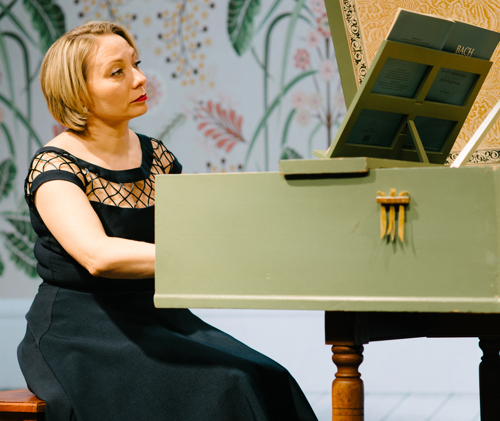Bach Series
Joanna Butler Harpsichord
BACH Nº 10
Joanna Butler performs the Sarabande from JS Bach's English Suite No. 3 in G minor, BWV 808

PROGRAM NOTES
(1685-1750)
ENGLISH SUITE NO. 3 IN G MINOR, BWV 808
Sarabande
JS Bach’s set of six ‘English’ suites for solo harpsichord remains a seminal work in the modern repertoire for keyboard players. However, as no autograph manuscript survives several tantalising ideas and misconceptions surround the collection.
Firstly, the title of ‘English Suites’ does not appear to have come from Bach himself. Johann Nicolaus Forkel, Bach’s first biographer, was the editor responsible at the start of the nineteenth century for the first publication of the collection titled, Grandes suites dites angloises pour le clavecin – literally translated, ‘Great suites called English for harpsichord’.
The English reference appears to stem from surviving manuscripts, including one copied by Bach’s youngest son, Johann Christian, who wrote ‘fait pour les anglois’ on the title page. This reference may have been misinterpreted by Forkel, who also suggests in his now-famous biography that the collection was composed by JS Bach for ‘an Englishman of rank’. Later scholarly inquiry has shown Johann Christian’s title only applies to the opening suite of the collection in A major. Sometime between 1709 and 1714, JS Bach copied a set of six suites for solo harpsichord by Charles Dieupart, a Frenchman working in London at the time. Dieupart’s works clearly left an impression on Bach; stylistic similarities exist between the two collections, and Bach also used one of Dieupart’s gigues as the basis for his A major prelude.
Another common misconception stems from Bach’s use of extensive preludes at the opening of each suite, as opposed to the Allemandes that open all six of his ‘French’ suites. Given the persuasive nationalistic titles of both collections, erroneous stylistic parallels are sometimes drawn when in fact both collections are a wonderful synthesis of German, Italian and French elements composed by arguably the most masterful craftsman of music.
Like many of the Brandenburg’s talented musicians, Joanna Butler first discovered JS Bach’s music at an early age:
![]()
Since I started playing music at the age of 7, JS Bach has been a composer from whom I have always had a piece to play, even if I was not always able to comprehend the music. Starting with very simple dance pieces that he wrote for his children, then more advanced works and finally pieces that demanded a lot from a player, I eventually grew to understand and fall in love with his music.
The English Suite No. 3 brings me back to the times when I was a university student and decided to play something not often performed by other keyboard players. The whole G minor suite, as for all the suites in that collection, has its own character. Bach equipped each of the suites with an amazing Sarabande, and some of them have written-out ornamented repeats.
Bach’s ornamentation is never just a random bunch of notes placed together on a piece of paper. It is very carefully thought out, based on an idea that fits with the harmonic structure of the piece. Along with many of his other works, the written-out ornamentations in the English suites are some of the most brilliant musical examples that show us exactly how those things were done back then. They give us a rare glimpse into how Bach himself likely improvised at his organ and harpsichord recitals.
JOANNA BUTLER
WHAT TO LISTEN FOR
An incredibly important facet of historically informed performance practice revolves around tempo, or how quickly one should play a piece. Although this Sarabande from the English Suite No. 3 in G minor does respect the characteristic rhythm, it would be unplayable in the tempo at which it ought to be danced. The music has a serious, almost solemn nature and, as mentioned above by Joanna Butler, Bach also adds extensive ornamentation, reinforcing the expressive power of the piece.
Program Notes: Joanna Butler & Hugh Ronzani, 2020
Image Credit: Katelyn-Jane Dunn, 2020
BACH SERIES PRESENTING PARTNER
Artists
Listen
{% error.message %}
More for you...
{% series.name %}
Featured Content
{% series.featuredTitle %}















